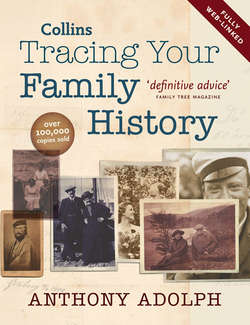Читать книгу Collins Tracing Your Family History - Ryan Tubridy, Anthony Adolph - Страница 127
HOW TO SEARCH
ОглавлениеDon’t run before you can walk, as the plethora of information available can be very confusing. If you have not used General Registration properly to trace back records to 1901, then focus on doing so: only when you have found the birth or marriage closest to 1901 is it time to start using censuses. Once you know exactly who was who at that time it is time to start using these exciting records. First, look for the family in the 1901 census. Even if you are not yet computer-literate, the ease with which people can now be found in online versions makes it worth your while learning how to use the search facility when trying this method, or prevailing on someone else to do it for you. The sites’ search facilities are easy to follow: if the name is a very rare one, just look at all the entries under your surname; if it is not, you can use the ‘advanced search’ options to narrow the search down, but be open-minded when you do so – just because someone lived in Kent, for example, does not mean they were definitely born there, and whilst men having children around 1901 were most probably aged between 18–40, they could have been anything from 12 to 80–plus!
If all goes well, you will find the family in the 1901 census. Your pennies are precious, of course, but please don’t stop when you see a transcription of the right entry – pay the extra and see (and print) the image of the original page. This (and not the transcription or index reference) is the original record, and you are far less likely to go wrong, or become confused, if you have this in front of you.
The people you have found in 1901 are likely to appear more or less ten years younger in the 1891 returns, so you can now seek them there, and if you are lucky you can work right back to 1841. At each stage, you will see the story of your family unfolding through the century – children growing up, leaving home, starting work, living with their young spouses and having children, and then grow older as their own children grow up and repeat the same process. Now that the returns are fully indexed you can do what we never could in the past, by finding children away at boarding school, or working in service, or people away on ships or in hotels or prisons, staying with relatives or working night-shifts in factories, and the elderly living with one of their grownup children, or in workhouses or hospitals. In fact, since the online censuses appeared, we can learn more about 19th century families than ever before, and with a better overview of what happened to these families than, in many cases, the families knew themselves. We live in privileged times indeed!
Do not ever base your research solely on censuses. Right back to 1837, birth and marriage certificates can be found, and you should always seek these for your direct ancestors, regardless of how complete you feel the census returns are. They will help you avoid making errors, and will tell you more detail than will be found in censuses. They compliment each other, and the details from both are very precious.
